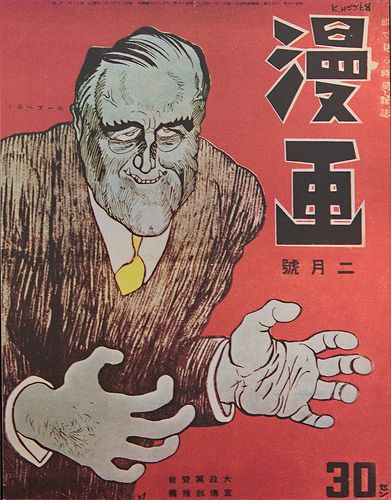WWII Propaganda Introduction
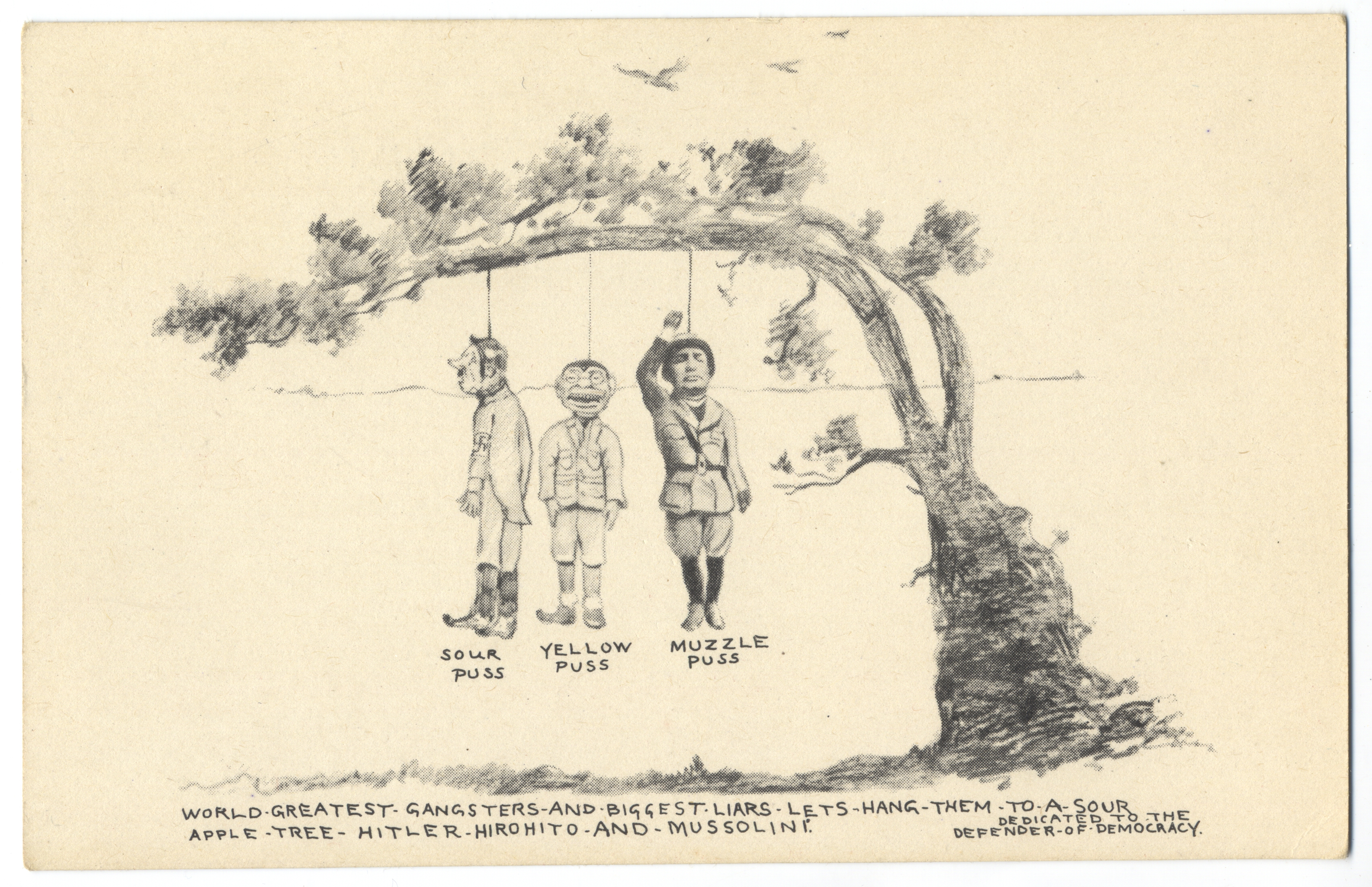
According to the Encyclopaedia Britannica:
Propaganda is the more or less systematic effort to manipulate other people’s beliefs, attitudes, or actions by means of symbols (words, gestures, banners, monuments, music, clothing, insignia, hairstyles, designs on coins and postage stamps, and so forth). Deliberateness and a relatively heavy emphasis on manipulation distinguish propaganda from casual conversation or the free and easy exchange of ideas. The propagandist has a specified goal or set of goals. To achieve these he deliberately selects facts, arguments, and displays of symbols and presents them in ways he thinks will have the most effect. To maximize effect, he may omit pertinent facts or distort them, and he may try to divert the attention of the reactors (the people whom he is trying to sway) from everything but his own propaganda. (Smith)
The sections below highlight propaganda posters and cartoons produced during World War II by Germany, the U.S.S.R., Japan, and the U.S.A.
Germany
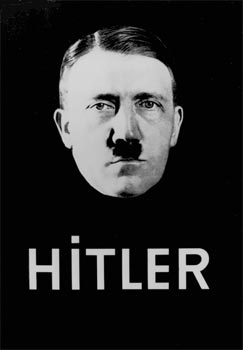
Van den vos Reynaerde: In this short, the donkey represents democracy and the rhinoceros represents Jewish people. Although the rhinoceroses claim all animals share in the ideals of the French Revolution’s doctrine of liberty, equality, and fraternity, they really consolidate power and usurp the donkeys. After taking over, they encourage the animals to rebel against natural order when they have children with one another (Barten).
U.S.S.R. (Soviet Union)
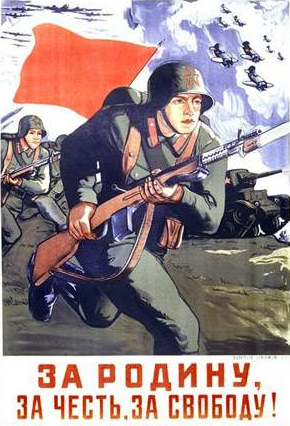
This poster shows a Soviet soldier at full charge towards the enemy. The caption reads: “For the Motherland, Honor, and Freedom!”
“Soviet WW2 Propaganda Cartoons Depicting Hitler.” YouTube. Accessed October 31, 2020. https://youtu.be/6mTgQh0xVvg. 3:18.
Kino-Circus: In this short Soviet cartoon, a Charlie Chaplin-like character introduces us to three short satires on Hitler. In the first part, “Hitler the Dog Trainer and His Pooches,” the dogs represent Mussolino, the leader of Italy; Horthy, the leader of Hungary; and Antonescu, the leader of Romania. In the second part “Hitler Visits Napoleon,” Hitler visits Napoleon’s tomb to ask for advice. In the third part “Adolf the Juggler on Powder Kegs,” the torchers represent the countries Hitler occupies (Grob).
Japan
Image of a ghoulish President Roosevelt found on a Japanese propaganda poster. For more posters like this one, check out this Japanese propaganda posters website.
“Evil Mickey attacks Japan – A 1936 Japanese Animation.” YouTube 1936. Accessed July 25, 2021. https://youtu.be/Eu7_P5aIyzQ. 7:53.
Evil Mickey Mouse: In this short cartoon, the Japanese depict Mickey Mouse as a representation of American imperialist evil. Several Mickey Mouses invade a peaceful island riding bats and using crocodiles and snakes like machine guns. The islanders appeal to Japanese legends to defend them: Momotaro the Peach Boy; Kintaro the Golden Boy; Issun-boshi the One Inch Boy; and Benkei the Warrior Monk (Mills).
The U.S.A.
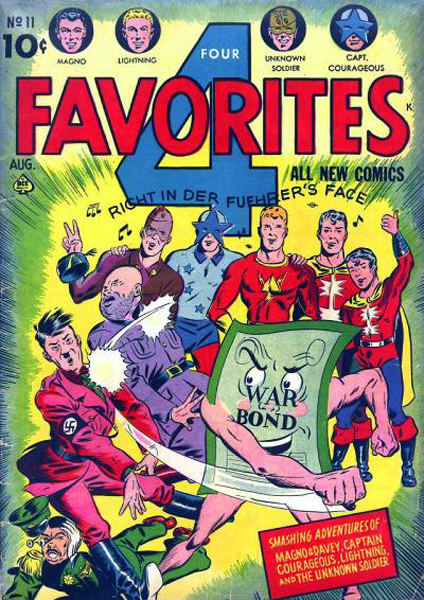
This August 1943 edition of a comic features a cover of a war bond defeating Mussolini, Hitler, and Tojo (leaders of Italy, Germany, and Japan, respectively). Access more American propaganda.
“Commando Duck.” Disney. YouTube. 1944. Accessed October 31, 2020. https://youtu.be/IzfnFeNPj1g. 6:52.
Even Disney contributed to American propaganda. In this short, Donald Duck parachutes into Japanese territory and destroys an enemy base. Take note of how Disney depicts the Japanese soldiers [transcript of the 1944 video]. Another Disney propaganda short was “Education for Death” (transcript of the 1943 video).
Knowledge Check
Use the following ungraded, self-check questions to confirm your learning for this module.
References
Barten, Egbert. “Dutch Anti-Semitic Colour Animation in World War II: Robert van Genechten’s Van den vos Reynaerde (1943).” Historical Journal of Film, Radio and Television 31 (2011): 1-41.
Grob, Gijs. “Kino-Circus.” Dr. Grob’s Animation Review. Accessed October 9, 2018. https://drgrobsanimationreview.com/tag/hitler/.
Mills, Ted. “’Evil Mickey Mouse’ Invades Japan in a 1934 Japanese Anime Propaganda Film.” Open Culture. Accessed October 9, 2018. https://www.openculture.com/2016/09/evil-mickey-mouse-invades-japan-in-a-1934-japanese-anime-propaganda-film.html.
Smith, Bruce Lannes. “Propaganda.” Encyclopaedia Britannica. Accessed August 12, 2018. https://www.britannica.com/topic/propaganda.

